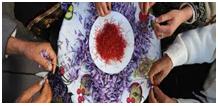In the Sirwa mountains of Morocco, members of the Coopérative Agicole de Taliouine (Taliouine Agricultural cooperative) supported by the Moroccan NGO Migrations et Développement are collecting one of the world’s most expensive spices: saffron.

In the Sirwa mountains of Morocco, members of the Coopérative Agicole de Taliouine (Taliouine Agricultural cooperative) supported by the Moroccan NGO Migrations et Développement are collecting one of the world’s most expensive spices: saffron.

The Souktan plateau of the Sirwa Mountains is home to the oldest variety of saffron in the world. Also known as “Crocus Saticus Linneaus”, this little blue flower is indentified as a cultivar—meaning it produces no seed and only reproduces through division. Taliouine saffron is of the highest-quality varieties of the spice because of the dry and cool climate of the mountains, the use of organic fertilizers –cow and lamb dung—and the expertise of the producers.
Typically during just one week at the end of October every year—60 percent of the yields are ready for harvesting. To avoid damaging the nutritional value and taste, it is very important that saffron be kept away from light throughout the harvesting process. Starting just before dawn, entire families work up to 20 hours a day handpicking the saffron. The farmers then remove the stigmas (filaments) by hand. It takes three hours to process a gram of saffron, which is made from 140 flowers and sold for between 10 and 30 euros ($14 to $43USD). Before heading to the market, Taliouine saffron is air-dried in glass or terracotta jars—creating a spicier taste— and stored in dark places. But heat drying – a more contemporary method—has also been used by the Taliouine people to produce a more fragrant saffron.
Saffron gives dishes—meat or vegetable—a bitter, honey-like taste and deep yellow color. The strong but delicate fragrance makes it easy to distinguish from similar spices—turmeric or calendula. The pigment from the stigma will even stain your finger and wooden spoons. Cooks use saffron in rice dishes like Spanish paella and Italian risotto.
Traditional medicine remedies include saffron for calming muscle spasms, soothing toothaches and releasing energy. Saffron can become lethal if used in high concentrations, causing hallucinations, convulsions, and even the risk of coma.
Saffron’s deep yellow pigment can also be used for Moroccan rooftops, threads in rugs, leather goods, and as make-up and dye for saris in South Asia. Even Cleopatra used saffron to preserve her skin’s beauty.
Traditionally, saffron collectors receive very little money for saffron—it’s sold at very low prices in local markets, but in European markets it sells for twice as much. The Taliouine Agricultural cooperative advocates for a fair trading system that is beneficial to the producer through implementing rules that preserve their traditional techniques. Slow Food International is also working in Morocco to protect saffron farmers by incorporating rules to sustain the farmer’s traditional practices.
As an important component that is helping to preserve Moroccan culture, this versatile spice is adding flavor in the kitchen, and beyond.
By Kaia E. Clarke

Danielle Nierenberg, an expert on livestock and sustainability, currently serves as Project Director of State of World 2011 for the Worldwatch Institute, a Washington, DC-based environmental think tank. Her knowledge of factory farming and its global spread and sustainable agriculture has been cited widely in the New York Times Magazine, the International Herald Tribune, the Washington Post, and
other publications.
Danielle worked for two years as a Peace Corps volunteer in the Dominican Republic. She is currently traveling across Africa looking at innovations that are working to alleviate hunger and poverty and blogging everyday at Worldwatch Institute’s Nourishing the Planet. She has a regular column with the Mail & Guardian, the Kansas City Star, and the Huffington Post and her writing was been featured in newspapers across Africa including the Cape Town Argus, the Zambia Daily Mail, Coast Week (Kenya), and other African publications. She holds an M.S. in agriculture, food, and environment from Tufts University and a B.A. in environmental policy from Monmouth College.
Get Weekly Inspiration & Stories
